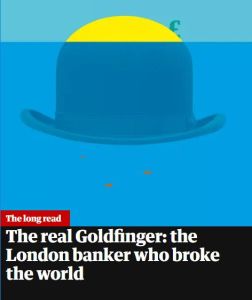
Oliver Bullough
The Real Goldfinger: The London Banker Who Broke the World
The Guardian, 2018
What's inside?
City of London bankers played a key role in creating extreme wealth inequality.
Recommendation
In the legendary 1964 James Bond movie Goldfinger, 007 goes after a business mogul who has devised an elaborate scheme to smuggle gold bullion out of Britain. For writer Oliver Bullough the plot illustrates how 1960s City of London financiers manipulated and eventually destroyed the post-World War II economic order. To learn more about the real-world consequences of their actions, getAbstract recommends you read Bullough’s highly entertaining essay.
Take-Aways
- In 2017, 42 individuals worldwide owned as much wealth as the poorest half of the global population.
- Extreme wealth concentration is a consequence of the collapse of the post-World War II monetary system of fixed exchange rates and restricted cross-border money flows.
- In 1962, a group of London financiers started issuing eurobonds that enabled Europeans to earn interest abroad while avoiding taxation.
- As the amount of US dollars circulating in the world economy multiplied, the United States was no longer able to back its currency with gold reserves, leading to the collapse of the fixed exchange-rate system.
- This resulted in a proliferation of international tax havens and the relaxation of money-flow restrictions, enabling the wealthy to invest freely and grow their fortunes while avoiding taxes.
Summary
The gap between the ultra rich and the rest of the world’s population has been widening at a rapid pace. In 2017, 42 individuals worldwide owned as much wealth as the poorest half of the global population. This concentration of extreme wealth is a consequence of the collapse of the post-World War II global monetary system, established by the Allied powers at the Bretton Woods Conference in New Hampshire in 1944. All parties to the Bretton Woods agreement pledged to maintain fixed exchange rates between their currencies and the US dollar. The United States, in turn, pegged its currency to gold at a fixed exchange rate of $35 per ounce. In doing so, the signatories sought to stabilize the world economy by restricting international money flows and preventing financial speculation. For a while, the system worked: Throughout the 1950s and 1960s, the Western economy experienced almost uninterrupted growth and growing economic equality. Since the system made it difficult for the wealthy to keep their money abroad, national governments were able to keep taxes high to pay for social services and infrastructure.
“The very rich getting very much richer is now part of life, like the procession of the seasons.”
The first crack in the system emerged when banks in the City of London started making loans in US dollars – also known as “eurodollars” (no connection with the euro currency) – to countries that didn’t want the United States to increase its political leverage over them by holding their money. In 1962, a group of London financiers, led by Siegmund Warburg, came up with the idea of issuing eurobonds to enable Europeans to earn interest on their savings while avoiding the high bond fees charged by US banks. To circumvent British taxes and national restrictions on cross-border money flows, the financiers issued the bonds in the Netherlands and paid the interest in Luxembourg while listing them on the London Stock Exchange. Within only five years, the eurobond market exceeded one billion dollars. As the amount of US dollars circulating within the system kept multiplying, the US government eventually saw itself forced to abandon the gold standard. Similarly, the United States had no way of preventing other countries from attracting foreign investments with lax regulations and low taxes, so it started to do the same to prevent capital flight from its own shores. An international race to the bottom ensued, enabling wealthy citizens and corrupt politicians to stash an ever increasing amount of money abroad while eschewing taxes and governmental scrutiny. The extreme inequality the new system of unfettered money flows has given the ultra rich a vastly disproportionate amount of power over national politics, which poses a fundamental risk to democracy.
About the Author
Oliver Bullough is the author of Moneyland: Why Thieves and Crooks Now Rule the World and How to Take It Back.
This document is restricted to personal use only.
My Highlights
Did you like this summary?
Read the articleThis summary has been shared with you by getAbstract.
We find, rate and summarize relevant knowledge to help people make better decisions in business and in their private lives.
Already a customer? Log in here.


















Comment on this summary